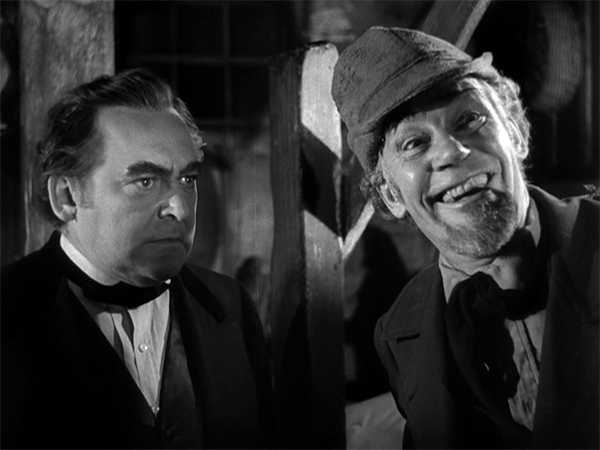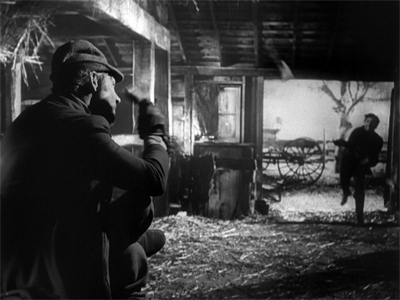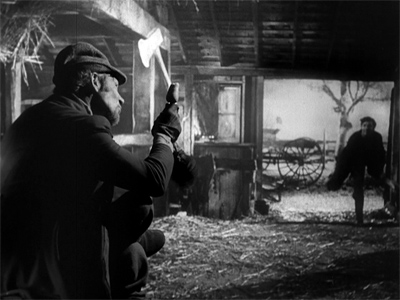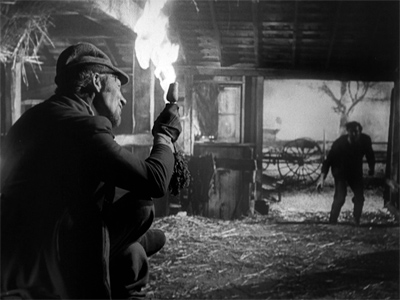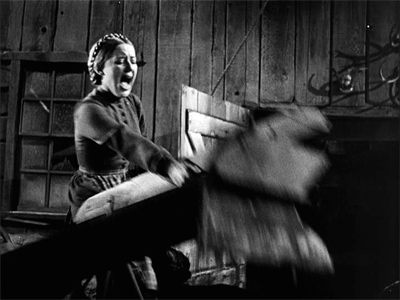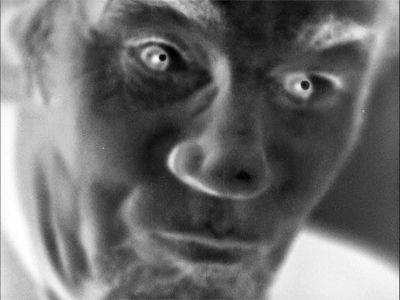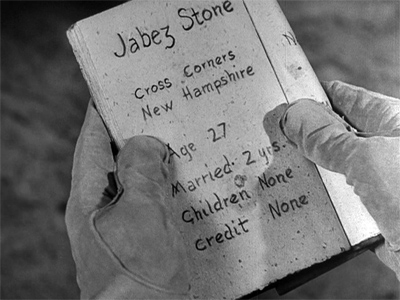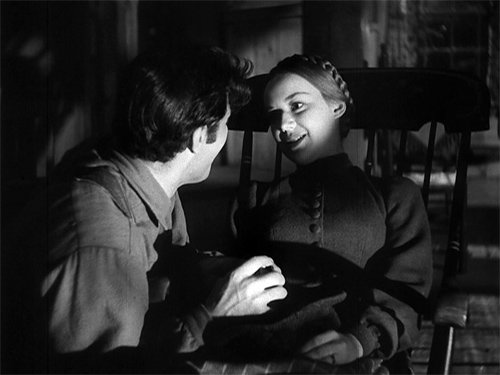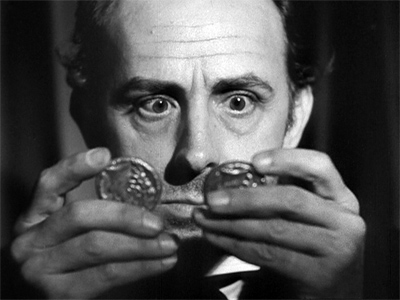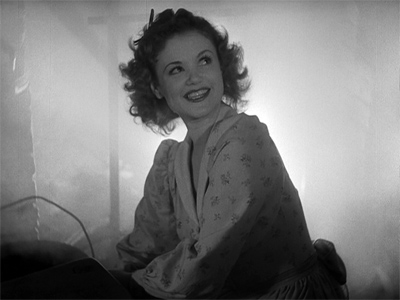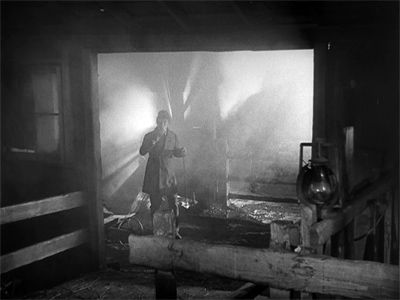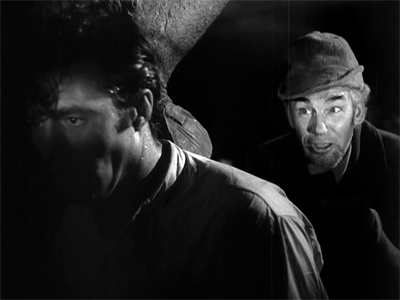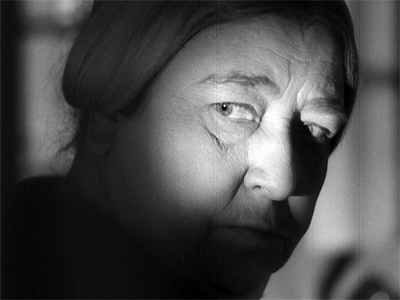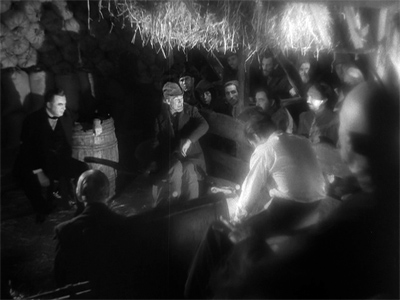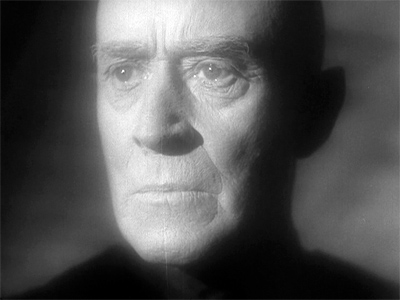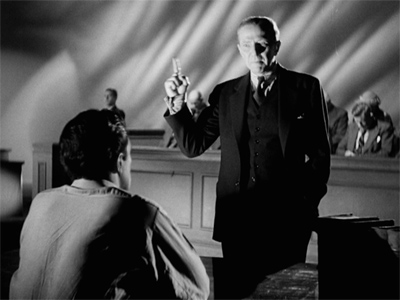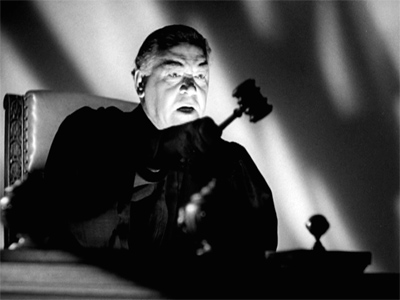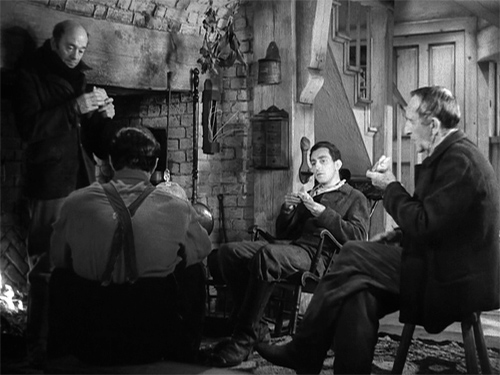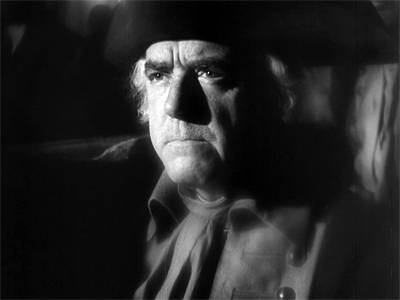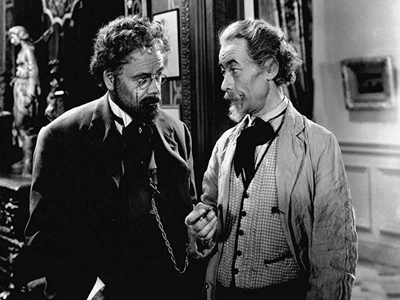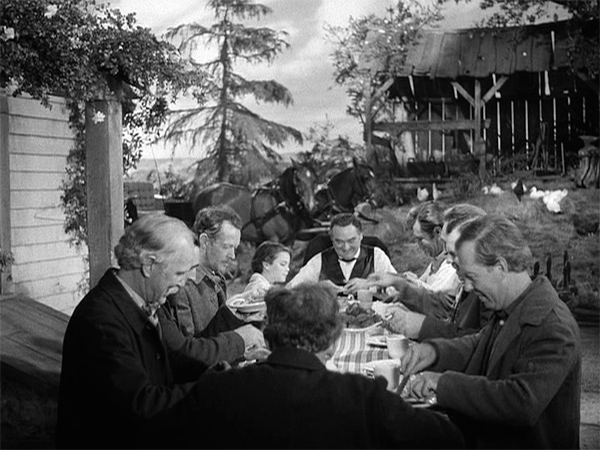The Devil and Daniel Webster (1941).
Jeff here:
Last week, the latest in our series of “Observations on Film Art” videos dropped on FilmStruck [2]. The topic this time was continuity editing in The Devil and Daniel Webster.
Many of our faithful blog readers are surely familiar with the techniques and devices that make up the continuity system. The video is really intended to be a primer for the uninitiated. It illustrates some of the basic formal elements of classical continuity, such as the eyeline match, shot/reverse shot, and the 180° rule.
In the video, I tried to highlight some of the reasons why the continuity system became common among popular cinemas around the globe. The tacit principles of the continuity system help ensure that:
- the story’s dimensions of space and time are clearly communicated to the audience
- characters’ and objects’ positions remain relatively constant from shot to shot
- that eyelines and screen direction stay consistent
- the spectator’s attention is guided to the most salient details in a scene.
The last may be the most important, if least understood. Several perceptual psychologists argue that one of the things that makes cinema a unique art form is its ability to produce attentional synchrony among viewers.
Editing is not the only means of guiding attention, to be sure. Filmmakers use lighting, composition, figure movement, camera movement, and blocking to nudge us to look at particular areas of the frame. The continuity system, though, further harnesses these shifts of attention by yoking them to the timing of cuts. Cuts are often coordinated with natural attention cues in a scene, such as conversational turns, changes in where the characters look, and pointing gestures. As Tim J. Smith, Daniel Levin, and James E. Cutting put it, “By piggy-backing on natural visual cognition, Hollywood style presents a highly artificial sequence of viewpoints in a way that is easy to comprehend, does not require specific cognitive skills, and may even be perceived by viewers who have never watched film before.”
In its deployment of classical Hollywood editing techniques, The Devil and Daniel Webster doesn’t do anything particularly special. Rather, in telling the story of how a New Hampshire farmer, Jabez Stone, sold his soul to the devil, it beautifully illustrates the clarity and efficiency of Hollywood craft at the height of the studio era. Indeed, the editing epitomizes the style of director William Dieterle as a whole: simple, direct, no fuss, no muss.
That being said, The Devil and Daniel Webster does add a few wrinkles to the usual Hollywood style. For example, it uses “trick film” techniques dating back to the era of George Melies to highlight the magical powers of the diabolical Mr. Scratch.
When Jabez throws an axe, it is initially seen as a blur heading straight for Scratch’s head.
A combination of stop-motion substitution and rear projection shows the axe freeze in midair.
A traveling matte is then used as the axe bursts into flames.
Moreover, the Criterion DVD contains deleted scenes from an earlier preview version of the film titled Here is a Man. This alternate version was, in fact, more formally adventurous than the one commonly seen by contemporary audiences. Each time something bad befalls Jabez during the first 20 minutes of the film, Here is a Man cuts to a few frames of photographic negative of Scratch. For instance, when Mary accidentally falls off a wagon, Dieterle cuts to Walter Huston smugly pursing his lips.
Dieterle and his collaborators wisely removed these shots from the final version of the film. The opening scene shows Scratch with Jabez’s name in a small book he carries with him.
When ruinous things start happening to Jabez, viewers naturally infer that Scratch caused them. The oddball moments in Here is a Man, unlike the other effects shots, don’t really add any new information and are heavy-handed in their symbolism.
The Long and the Short of It: Adapting Stephen Vincent Benét to the Silver Screen
Beyond offering good examples of editing craft, The Devil and Daniel Webster is of interest today for other reasons. One involves some of the creative choices made by Stephen Vincent Benét and Dan Totheroh in adapting the former’s short story, first published by The Saturday Evening Post in 1936. The second issue I’ll explore has to do with the way the film speaks to political issues of its moment. It seems endorse a collectivist vision of society as a counter to the excesses of unrestrained capitalism.
Most film adaptations use books for their source material, and most screenwriters face the challenge of condensing the book’s narrative to fit the running time of a typical feature film (roughly about two hours). In the case of The Devil and Daniel Webster, Benét and Totheroh faced the opposite problem.“The Devil and Daniel Webster” runs less than twenty pages in a Hythloday Press collection of Benét’s short stories. So how do you stretch Benét’s relatively slim tale to fit a 107 minute running time? Benét and Totheroh did what most screenwriters do when they confront the same dilemma. They add incidents, invent new characters, and develop new subplots, adding this material to the existing story spine.
Some print editions of Benét’s story break it into five parts with each new segment introduced with a Roman numeral. Part I introduces Daniel Webster via the tall tales told about him in the New England area. It also provides exposition to Jabez’s blighted existence, and the deal he makes with the devil. After breaking his plow on a stone, Jabez angrily proclaims, “I vow it’s enough to make a man want to sell his soul to the devil. And I would, too, for two cents!”
Part II covers the seven-year period of prosperity Jabez enjoys as well as his interest in contesting the mortgage held by the mysterious stranger. This section also establishes the stranger’s mystical powers as Jabez hears the voice of his neighbor, Miser Stevens, coming from a moth-like creature that the stranger captures in a bandanna.
Part III describes Jabez’s recruitment of Daniel Webster for his defense and the preparations for trial. Parts IV and V depict the trial itself. The former introduces the judge and jury, and portrays Daniel’s passionate defense of Jabez. The latter tells of the jury’s verdict and Daniel’s banishment of Mr. Scratch from New Hampshire.
One of the most striking things about Benét’s original story is how much of it focuses on the trial itself. Approximately half of the story covers Webster’s initial deliberations with Mr. Scratch, his demand for a trial, and the legal proceedings. In contrast, these story events account for less twenty percent of the film’s running time.
In expanding the story to feature length, Benét and Totheroh add new incidents, characters, and subplots to the early and middle sections of the screenplay. Consider, for example, Benét’s economy in his prose description of Jabez’s misfortunes:
If he planted corn, he got borers; if he planted potatoes, he got blight. He had good-enough land, but it didn’t prosper him; he had a decent wife and children, but the more children he had, the less there was to feed them. If stones cropped up in his neighbor’s field, boulders boiled up in his; if he had a horse with the spavins, he’d trade it for one with the staggers and give something extra.
Years of toil and trouble for Jabez are compressed into three sentences. When Jabez breaks his plowshare, it becomes simply the proverbial straw on the camel’s back, coming at a time when his wife and children are sick and even his horse has a rheumy cough.
In their script, Benét and Totheroh create a handful of new vignettes to illustrate Jabez’s rotten luck. In the film’s first scene, Jabez’s pig breaks its leg after being chased by the family dog. Later, Jabez’s wife, Mary, takes a tumble off their wagon when trying to stop her husband from selling the family’s calf. Still later, a fox gets into Jabez’s henhouse. In the film, Jabez’s breaking point comes not with the plow, but after he spills precious seed in a puddle just outside his barn. Unlike the story’s description of blight and corn borers, these brief episodes not only visualize Jabez’s tribulations, but also contain their own short dramatic arcs.
Another way Benét and Totheroh expand the original story is to add depth and specificity to its secondary characters. In the original, Miser Stevens never appears as anything more than an insect that’s escaped from Scratch’s collecting box. In the film, he is much more fully fleshed-out character, especially as embodied by the wonderful character actor, John Qualen.
Benét and Totheroh’s screenplay uses Stevens to create important story parallels. Like Scratch, who possesses a mortgage on Jabez’s soul, Stevens holds the mortgage to the Stone farm. Yet, Stevens also has made a Faustian bargain with Mr. Scratch. His death at Jabez’s party lingers over the rest of the film, a vivid reminder of what’s at stake during the trial.
Benét’s story also treats Jabez’s wife and children quite impersonally. The characters are never named. The references to them mostly add narrative weight to Jabez’s sense of burden. In contrast, the film version not only give these characters names and individual traits, but also uses them to highlight changes Jabez undergoes once he becomes a wealthy landowner. Jabez and his wife, Mary, frequently argue about disciplining their son, Daniel. Jabez indulges Daniel, spoiling him but offering little in the way of love. Similarly, after becoming successful, Jabez also falls short of what we’d expect of a caring husband.
In the middle parts of the film, Jabez becomes crueler and harder. He starts treating trespassers on his land more harshly. He even fires a weapon at one in an effort to scare him away. His anti-social attitudes make him an outcast among the citizenry of Cross Corners.
As was the case with Jabez’s family, the film gives the townspeople more life and personality. Early on, they serve to motivate Daniel Webster’s presence in the story, welcoming him to Cross Corners and serving as a receptive audience for the Senator’s political views. Later, the townspeople act as a foil for Jabez, establishing an important thematic contrast between his laissez faire mindset and their more communitarian values.
Lastly, Benét and Totheroh also invent several new characters for the film adaptation. Of these, the most important is Belle. Loosely allied with Mr. Scratch, Belle is ostensibly Daniel’s nanny, but is implied to be Jabez’s mistress. Belle supplies a sexual temptation not present in the original story, and this complements the temptations of wealth and power. In this respect, the character anticipates the femme fatales found in the cycle of films noir that appear later in the forties, especially as played by Simone Simon at her most fetching.
Although Dieterle was best known for costume pictures rather than film noir, the photographic style of The Devil and Daniel Webster sometimes displays the kind of dark, moody look we associate with noir’s Germanic influence. Consider, for example, the shot of Scratch’s entrance into Jabez’s barn. The mists, the backllight, and the gnarled tree in the background all foreshadow the darkness that will soon take hold of Jabez’s soul.
In the case of The Devil and Daniel Webster, tracing the film’s lineage back to German expressionism is fairly easy. Prior to becoming a director, Dieterle was an actor in dozens of German silent films, including F.W. Murnau’s Faust (1926). Murnau’s adaptation of Goethe’s play not only shares its narrative conceit with Dieterle’s film, but is also one of the most strikingly photographed of his twenties masterpieces.
Looking both backward and forward, The Devil and Daniel Webster might seem like a link between German Expressionism and American film noir. Like German films of the 1910s and 1920s, Dieterle’s film contains some of the fantasy elements found in canonical titles like The Student of Prague (1913), Der Golem (1915), or The Cabinet of Dr. Caligari (1920). Dieterle’s curious afterlife fantasy Six Hours to Live (1932), discussed in an earlier entry [13], has a strong affinity with Gothic and Expressionist imagery. Like films noir of the forties, the cinematographic style of The Devil and Daniel Webster captures the story’s dark, fatalistic tone.
Indeed, the look of the final trial scene displays the same sort of stylization seen in the dream sequence of The Stranger on the Third Floor (1940), a film often seen as a key noir progenitor.
Still, Dieterle also retains the folksy Americana that was an appealing part of Benét’s original story. Some of the characters, like Ma Stone or Squire Slossum, seem like they’ve wandered into the story from one of Frank Capra’s small towns or John Ford’s rural comedies. This combination makes The Devil and Daniel Webster a true original. Indeed, it might count as an almost singular example of “cracker barrel noir” if the term itself didn’t seem like a complete oxymoron.
Things That Make a Country a Country, and a Man a Man: Benét’s Tale as Allegory
One of the other things that interests me about The Devil and Daniel Webster is the degree to which both the story and the film can be read as allegory. Benét’s original narrative certainly makes American identity a central theme. The opening paragraph proposes that, if you go to Daniel Webster’s gravesite and call his name, you’ll hear his deep, rolling voice ask, “Neighbor, how stands the Union?” Benét adds, “Then you better answer the Union stands as she stood, rock-bottomed and coppersheathed, one and indivisible, or he’s liable to rear right out of the ground.” This description not only foreshadows the oratorical power that Webster will display when Jabez goes on trial, but also the sacrifices Scratch prophesies. These include Webster’s loss of two sons in combat and a missed opportunity to become president.
Later, Webster will challenge Scratch on the grounds of his nationality, saying “no American citizen may be forced into the service of a foreign prince.” Scratch responds that he is an American, and further that he was present for “the first wrong done to the first Indian” and when the first American slave ship set sail for the Congo. Moreover, when Scratch assembles his jury, he selects a group of black-hearted souls whose dark deeds affected the course of the nation’s history. Among them is the pirate Edward Teach, otherwise known as Blackbeard. There’s also Walter Butler, the architect of the Cherry Valley massacre; Simon Girty, who burnt men at the stake; and Governor Thomas Dale, who Benét claims “broke men on the wheel.” Overseeing the proceedings is Judge John Hathorne, a magistrate in Salem who supervised some of the witch trials.
The larger significance of these passages is hard to ignore. Jabez may be on trial within the narrative, but Benét seems to put America itself on trial. The plaintiff and defendant, thus, come to symbolize the yin and yang of America’s soul. Webster represents the virtues that define the American ethos: grit, pluck, ingenuity, and liberty. Scratch, on the other hand, associates himself with the nation’s original sins: genocide, slavery, cruelty, torture, and theocratic inquisition. Webster emerges victorious in the legal battle, but as he says in his summation, our citizens’ hard-won freedom came at a cost of suffering and tribulation. Successes and failures are all part of the great journey of humanity. Says Webster, “And everybody had played a part in it, even the traitors.”
Dieterle’s film preserves all of these elements of Benét’s short story, but adds a couple of wrinkles of its own. First, General Benedict Arnold is added to the film’s panel of jurors, even though he is pointedly absent from the original. In the story, Webster observes that he misses Arnold’s company and is told that the General is engaged in other business. Benedict Arnold is not only fully present in the film version, but is even featured prominently during the trial scene in several medium close-ups.
Webster even singles out Arnold in his impassioned defense of Jabez’s character. Using Arnold’s betrayal of his country as a cautionary tale, the orator asks the jury to give Jabez the second chance that the devil denied to them.
The other, even more important, change made by Benét and Totheroh is the subplot concerned with the formation of the Grange. Officially known as the Order of the Patrons of Husbandry, the Grange was founded in 1867 to promote the interests of farmers and rural communities. But Webster died in 1852. As an addition to the screenplay of The Devil and Daniel Webster, the Grange seems to be a historical anomaly.
So why this anachronistic subplot? The simple answer is that it sharpens the conflict between Jabez and the other townspeople. Not only is he differentiated in class, but he’s set apart by his personal values. The less obvious answer involves the film’s historical context. Released in 1941, the story of a lone holdout resisting the pressure of others in his community likely would evoke broader geopolitical issues. The plea for unity in the face of existential evil would seem to suggest The Devil and Daniel Webster works as an allegorical critique of American isolationism on the threshold of World War II.
Like other allegories, this type of reading follows a pattern of metaphorical substitution. The Grange becomes a stand-in for the Allied Powers. Scratch represents Hitler, Mussolini, Tojo, and other Axis leaders. And, as discussed above, Stone and Webster symbolize America itself.
Dieterle’s earlier career in Hollywood also offers some additional warrant for this interpretation. He was a German Jew who emigrated to the U.S. in 1930. His relocation was less about fleeing the Nazis than it was the opportunity to work for Warner Bros. Still, Dieterle bore witness to the corrosive effects of Nazi ideology, and his directorial assignments show a loose affiliation with anti-Fascist politics. He helmed The Life of Emile Zola, a Warners biopic that depicts the French author’s involvement in the Dreyfus affair. The film won the Oscar for Best Picture in 1938. Thanks to its timely exploration of anti-Semitism, Zola burnished Warner Bros. reputation as Hollywood’s most socially conscious studio.
That same year, Dieterle directed Blockade (1938) for producer Walter Wanger. Although it is mostly a routine espionage thriller, the film is now remembered as one of the few films Hollywood made about the Spanish civil war. As scripted by John Howard Lawson, who later was blacklisted as one of the Hollywood Ten, Blockade is now seen as an emblem of the Popular Front. Most film historians associate it with anti-Fascist politics, even though the film pointedly avoids identifying the Loyalist and Nationalist sides of the conflict.
Unlike these previous projects, The Devil and Daniel Webster positioned Dieterle as both producer and director. The creative decisions involved in the addition of the Grange subplot would seem more directly under his control. The film’s thematic emphasis on collective interests seems to suggest this political subtext in much the same way that Alfred Hitchcock’s Lifeboat (1944) is sometimes viewed as a parable of democracy’s failure in the face of dictatorship.
In highlighting this allegorical dimension of The Devil and Daniel Webster, I don’t wish to suggest that it makes the film inherently more interesting. Indeed, like other allegorical interpretations, it seems a bit reductive and simplistic. More importantly, if taken too far, these types of interpretive strategies quickly become wrongheaded and even silly (i.e. Belle as a stand-in for Vichy collaboration).
Yet, I also can’t help but feel that The Devil and Daniel Webster’s invocation of American identity offers something important to a contemporary audience. If, like me, you bristle every time you hear “American interests” referenced as the reason to abandon the Paris Accords or to potentially withdraw from NATO, then you have a sense of the film’s relevance to our moment.
The whole arc of the Grange subplot seems to invert much contemporary political rhetoric insofar as it dramatizes the social benefits of the Commons and the individual tragedy of self-interest. In the parlance of our times, Jabez is a risk-taker, mortgaging his immortal soul for the promise of earthly riches. Yet, when we see the resulting inequality in Dieterle’s film, we recognize the situation for what it is. For Jabez, Miser Stevens, and other capitalist mountebanks, it is, quite literally, a deal with the devil. And that, consarn it, is a lesson that all modern viewers can take to heart.
A handy introduction to the continuity system can be found in Chapter 6 of Film Art [23].
To learn more about the role of editing in guiding viewers’ attention, see Tim J. Smith, Daniel Levin, and James E. Cutting, “A Window on Reality: Perceiving Edited Moving Images,” Current Directions in Psychological Science 21, no. 2 (2012): 107-113. A PDF of this essay can be found here [24].
Stephen Vincent Benét can be found in many places around the web, including here [25]. Lotte Eisner’s The Haunted Screen: Expressionism in the German Cinema and the Influence of Max Reinhardt [26](1974, University of California Press) remains a useful introduction to the movement’s lighting and visual motifs. For more on the interpretation of films as political allegories, see my book Film Criticism, the Cold War, and the Blacklist: Reading the Hollywood Reds [26] (2014, University of California Press).
The Devil and Daniel Webster (1941).
